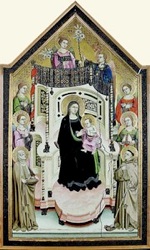
This important follower of Giotto is named for a panel in the Collegiata of Figline Valdarno, near Florence, which depicts the Madonna and Child enthroned with SS Elizabeth of Hungary and Louis of Toulouse and six angels. The panel, which was first documented in this location in 1875, was probably executed for a Franciscan church in the area. The presence of the two “Angevin” Franciscan saints suggests that was commissioned as a Guelf statement during the descent into Italy the Emperor Henry VII in 1310-3.
Other works attributed to this master were mostly painted in Florence or Assisi in ca. 1310-30. Besides those described below, these include the painted crucifix (ca. 1320) that remains above the high altar of Santa Croce, Florence.
Assisi
Madonna and Child with saints (early 14th century)

The fresco, which is some way above ground level, seems to have been largely forgotten until 1929, when its lower part was rediscovered below a false ceiling that had been inserted in the sacristy in 1626. It became fully visible after a fire destroyed the ceiling in 1952, and was restored two years later.
Stigmatisation of St Francis (early 14th century)
This damaged fresco on the right wall of Santa Maria della Rocchicciola (at Rocca Sant’ Angelo, outside Assisi) is also attributed to this master.



